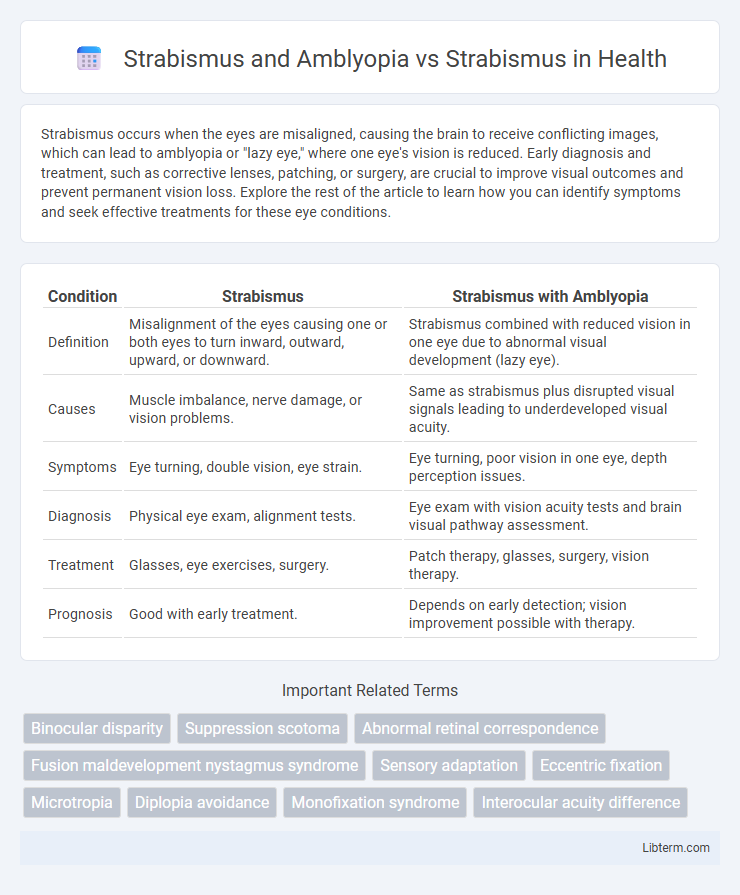Strabismus occurs when the eyes are misaligned, causing the brain to receive conflicting images, which can lead to amblyopia or "lazy eye," where one eye's vision is reduced. Early diagnosis and treatment, such as corrective lenses, patching, or surgery, are crucial to improve visual outcomes and prevent permanent vision loss. Explore the rest of the article to learn how you can identify symptoms and seek effective treatments for these eye conditions.
Table of Comparison
| Condition | Strabismus | Strabismus with Amblyopia |
|---|---|---|
| Definition | Misalignment of the eyes causing one or both eyes to turn inward, outward, upward, or downward. | Strabismus combined with reduced vision in one eye due to abnormal visual development (lazy eye). |
| Causes | Muscle imbalance, nerve damage, or vision problems. | Same as strabismus plus disrupted visual signals leading to underdeveloped visual acuity. |
| Symptoms | Eye turning, double vision, eye strain. | Eye turning, poor vision in one eye, depth perception issues. |
| Diagnosis | Physical eye exam, alignment tests. | Eye exam with vision acuity tests and brain visual pathway assessment. |
| Treatment | Glasses, eye exercises, surgery. | Patch therapy, glasses, surgery, vision therapy. |
| Prognosis | Good with early treatment. | Depends on early detection; vision improvement possible with therapy. |
Understanding Strabismus: Definition and Types
Strabismus, characterized by the misalignment of the eyes, includes multiple types such as esotropia, exotropia, hypertropia, and hypotropia, each affecting binocular vision differently. Strabismus combined with amblyopia, often termed "lazy eye," involves reduced vision in one eye due to improper alignment, leading the brain to favor the dominant eye and impair depth perception. Understanding the distinctions between isolated strabismus and its association with amblyopia is crucial for effective diagnosis and treatment planning in pediatric and adult ophthalmology.
What is Amblyopia? Causes and Symptoms
Amblyopia, commonly known as "lazy eye," is a vision development disorder where an eye fails to achieve normal visual acuity, often caused by strabismus, refractive errors, or deprivation during childhood. The primary symptoms include poor vision in one eye, eye misalignment, and suppressed visual input, leading to reduced depth perception and difficulty in focusing. Unlike isolated strabismus, which is the misalignment of eyes, amblyopia results from the brain favoring one eye over the other, causing permanent visual impairment if untreated early.
Strabismus vs. Amblyopia: Key Differences
Strabismus is a condition characterized by the misalignment of the eyes, where they do not look in the same direction, while amblyopia, also known as lazy eye, is a developmental problem resulting in decreased vision in one eye due to abnormal visual experience during childhood. The key difference lies in strabismus being a structural or muscular issue causing eye misalignment, whereas amblyopia is a neurological condition affecting visual processing in the brain. Early diagnosis and treatment of strabismus can prevent amblyopia by promoting proper visual development and binocular vision.
The Relationship Between Strabismus and Amblyopia
Strabismus, a misalignment of the eyes, frequently leads to amblyopia, also known as lazy eye, due to the brain favoring one eye over the other to avoid double vision. The suppression of visual input from the misaligned eye during critical developmental periods results in reduced visual acuity and impaired binocular vision, characteristic of amblyopia. Early diagnosis and treatment of strabismus are crucial to prevent or minimize amblyopia and preserve normal visual development.
Risk Factors for Strabismus and Amblyopia
Strabismus and amblyopia share common risk factors such as premature birth, family history of eye disorders, and neurological conditions that affect eye muscle control. Uncorrected refractive errors and anisometropia often contribute specifically to amblyopia development by causing unequal visual input, leading to neural suppression. Early detection and intervention targeting these risk factors significantly improve outcomes in managing both strabismus and amblyopia.
Diagnostic Approaches for Strabismus and Amblyopia
Diagnostic approaches for strabismus involve comprehensive ocular alignment testing using cover-uncover and Hirschberg tests to evaluate binocular function and eye deviations. In amblyopia, diagnosis requires visual acuity assessments, often complemented by cycloplegic refraction to identify refractive errors causing reduced vision. Both conditions benefit from early detection through pediatric eye screenings to prevent long-term visual impairment.
Treatment Options for Strabismus Alone
Treatment options for strabismus alone primarily include glasses, prism lenses, vision therapy, and surgical correction to realign the eyes. Eye muscle surgery adjusts the strength or positioning of the eye muscles to improve alignment and binocular vision. Non-surgical methods like patching or exercises can strengthen weaker muscles and enhance coordination in cases where surgery is not immediately required.
Managing Combined Strabismus and Amblyopia
Managing combined strabismus and amblyopia requires a coordinated approach to address both eye misalignment and visual development deficits. Treatment often includes corrective lenses, patching or atropine therapy to strengthen the weaker eye, and surgical intervention to realign the eyes for improved binocular function. Early diagnosis and consistent adherence to therapy significantly enhance outcomes by promoting better visual acuity and depth perception.
Prognosis and Long-term Outcomes
Strabismus combined with amblyopia often results in more complex prognoses compared to isolated strabismus, as amblyopia can cause permanent vision loss if not treated early. Long-term outcomes improve significantly with early intervention, including corrective surgery and vision therapy, yet untreated amblyopia leads to persistent functional deficits. In contrast, strabismus without amblyopia generally has better recovery potential with alignment surgery, though untreated cases may still risk binocular vision impairment.
Prevention Strategies and Early Intervention
Early intervention in strabismus and amblyopia significantly improves visual outcomes by promoting proper eye alignment and preventing permanent vision loss. Prevention strategies include routine pediatric eye screenings and prompt treatment with corrective lenses, patching, or vision therapy to address deviations and strengthen the weaker eye. Identifying strabismus early allows for timely management, reducing the risk of amblyopia development and enhancing binocular vision function.
Strabismus and Amblyopia Infographic

 libterm.com
libterm.com